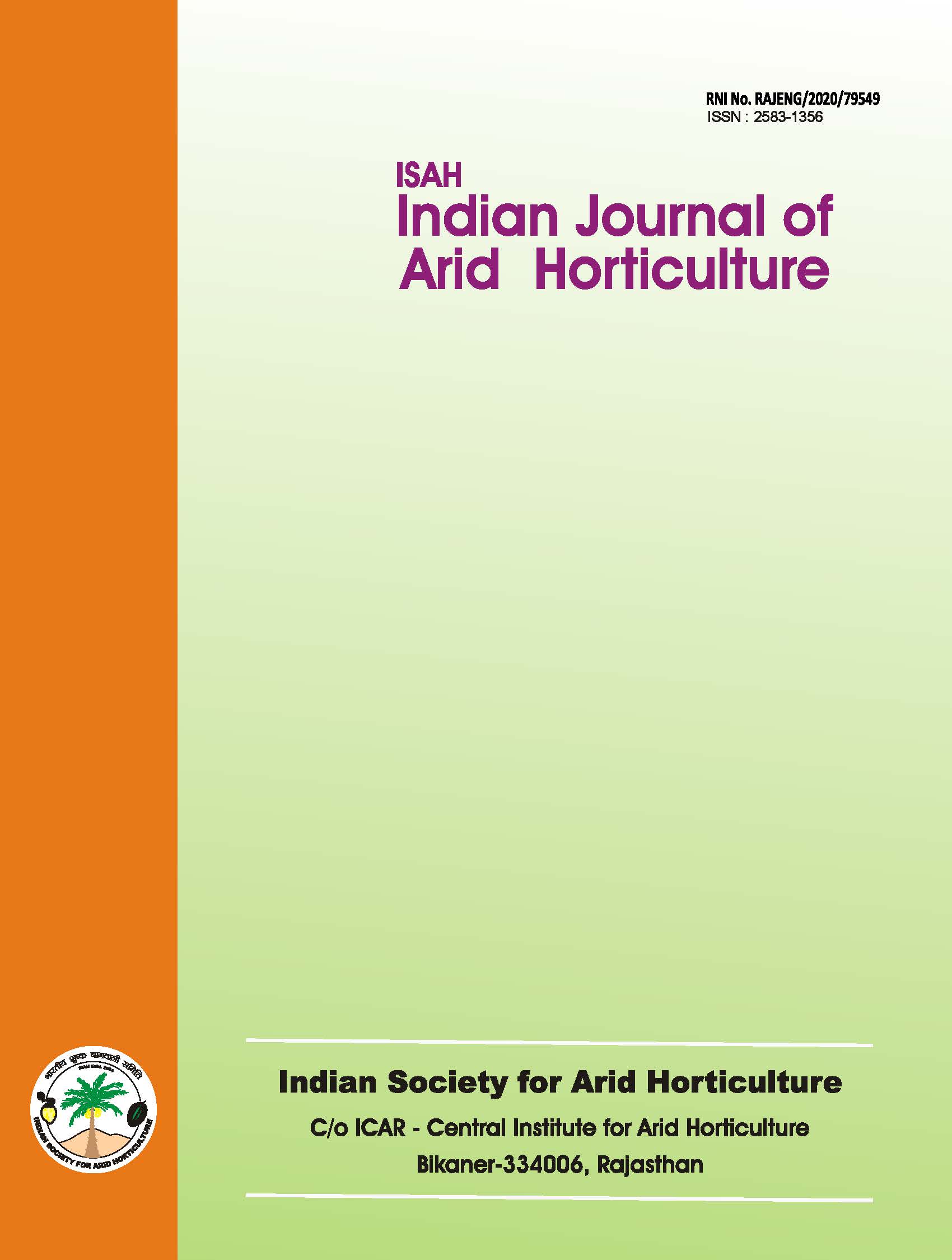Management of Alternaria leaf blight of Mateera (watermelon) by fungicides, bio-agents and botanical
Keywords:
Alternaria leaf blight, mateera (watermelon), bio-agents, botanical, fungicides, managementAbstract
The field trials were conducted for management of Alternaria leaf blight (Alternaria cucumerina var. P. watermelon) in mateera (watermelon) by fungicides, bio-agents and botanical during summer season of 2013 and 2014 at Plant Pathology Block of ICAR-Central Institute for Arid Horticulture, Bikaner (Rajasthan). Three fungicides (copper oxychloride, carbendazim and mancozeb), four bio-agents (Aspergillus niger, Pseudomonas fluorescens CIAH-196, Trichoderma viride CIAH-240 and Trichoderma viride Non-Resistant) and one botanical such as onion leaf extract were taken for the study. Disease incidence and disease severity of Alternaria leaf blight in mateera ranged from 10.0 to 34.17% and 8.88 to 29.01%, respectively. Among nine treatments, one foliar spray of mancozeb (0.25%) proved the most effective fungicide for the management of this disease in mateera under field conditions with the minimum disease incidence (10.0%) and disease severity (8.88%) and the maximum disease control (69.39%). Further, next best treatment was Trichoderma viride CIAH-240 (5%). However, the maximum disease incidence (34.17%) and disease severity (29.01%) were observed in control followed by onion leaf extract (5%) with disease incidence (27.85%), disease severity (24.34%) and the minimum disease reduction (16.09%).Downloads
References
Anonymous, 2003. Annual Report (2002-03), Central Institute
for Arid Horticulture, Bikaner (Rajasthan).
Batta, Y. 2003. Alternaria leaf spot disease on cucumber: susceptibility and control using leaf disk assay. An-Najah University Journal of Research, 17(2): 269-279.
Bhargava, A. K. and Singh, R. D. 1985. Comparative study of Alternaria blight, losses and causal organisms of cucurbits in Rajasthan. Indian J. of Mycol. Pl. Pathol., 15: 150-154.
Deshmukh, V. S., Dhruj, I. U. and Chanvan, T. V. 2007. Chemical control of purple blotch (Alternaria porri)
of onion. Plant Disease Research, 22: 34-36. Dushyant, Khatri, N. K., Prasad, J. and Maheshwari, S. K.
2014. Efficacy of fungicides against early blight of tomato caused by Alternaria solani. Ann. Pl. Protec. Sci., 22 (1): 148-151.
Ilhe, B. M., Shinde, H. N., Bhalekar, M. N. and Kshirsagar, D.
B. 2008. Management of fungal disease complex of tomato. Journal of Plant Disease Science, 3 (2): 173- 175.
Khandelwal, G. L. and Prasada, R. 1970. Taxonomy, physiology and control of Alternaria leaf spot of watermelon (Citrullus lanatus). Indian Phytopathology, 23:32-36.
S. K. Maheshwari, B. R. Choudhary, D. Singh, B. D. Sharma and S. K. Sharma, Indian Journal of Arid Horticulture, 2015, Vol. 10 (1-2):64-67
Mane, M. M., Lal, A., Zghair, Q.N. and Simon, S. 2014.
Efficacy of certain bio-agents and fungicides against early blight of potato (Solanum tuberosum L.). International Journal of Plant Protection, 7 (2): 433- 436.
Pandey, N. K., Purushottam, Gupta, R. C. and Mishra, R. K. 2008. Management of foliar diseases of onion. Annual Report (2008). National Horticultural
Research and Development Foundation, Nashik (Maharashtra), India.
Prasada, R., Khandelwal, G. L. and Jain, J. P. 1973. Epidemiology, forecasting and control of Alternaria blight of cucurbits. Proceedings of Indian National Science Academy, 37: 301-308.

